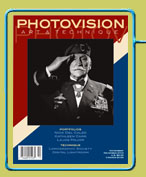![]()
| By: Robert Hirsch From Vol. 1 No. 3 In My Opinion |
13. A common complaint of some beginning photographers is that there is no artistic subject matter in their locale.
Today a central characteristic of imagemaking is not only to create objects (photographs), but also to escape the restrictive parameters of their objectness through content. However, it is a common misconception to link content solely with the subject matter being represented. Photographs that affect people may have nothing to do with the apparent subject matter, and everything to do with the subsequent treatment of that subject. This realization creates limitless potential for subject matter.
Light is a vital component of every photograph. This was recognized early in the medium’s history by William Henry Fox Talbot’s, The Pencil of Nature (1844 - 1846), the first book to be fully illustrated by his paper calotype process. Talbot’s selection of images, such as The Open Door, 1843, demonstrate his belief that subject matter was “subordinate to the exploration of space and light.” The quality of light striking a subject can reveal or supress its characteristics, which will make or break a photograph. Light may be natural or artificial, but without the appropriate type of light even the most fascinating subjects become inconsequential.
Ultimately light is a principal subject of every photograph that imagemakers must strive to control and depict. As Talbot stated,
“A painter’s eye will often be arrested where ordinary people see nothing remarkable. A casual gleam of sunshine, or a shadow thrown across his path, a time-withered oak, or a moss-covered stone may awaken a train of thoughts and feeling, and picturesque imaginings.”
This is the realization that the subject in front of the lens is not always the only subject of the photograph.
14. It’s been done before.
To accept the notion it has all been done before is to embrace clichés. The problem with clichés is not that they are erroneous, but that they are superficial and oversimplified articulations of complex concepts. Clichés are detrimental because they encourage photographers to believe that they have done a sufficient job of recording a situation when in fact they have merely gazed at its surface. The simple act of taking a photograph of Niagara Falls or a pepper is no guarantee that one has communicated anything essential about that subject.
Good photographers provide visual clues and information about their subject for the viewer to contemplate. They have learned how to distill and communicate what is essential to them about their subject. By deeply exploring a theme and challenging clichés, photographers can reconstruct their sight and gain a fresh awareness and understanding.
15. I’m not in the right mood to make photographs.
Responding to life with joy and sorrow is part of the human condition. At times when pain and suffering are inescapable, it is important to remember that this is part of the process by which we acquire knowledge. This does not mean that one must be in discomfort to make art, but stress can be channeled into a creative force if it produces a sense of inquisitiveness and an incentive for change. Thinking through making pictures can allow us to place our pain in context. The images we make can help us understand its source, catalog its scope, adapt ourselves to its presence, and devise ways to control it. There are things in life, once called wisdom, which we have to discover for ourselves by making our own private journeys. Stress can open up possibilities for intelligent and imaginative inquiries and solutions that may have otherwise been previously ignored overlooked or refuted.
16. I have no idea how I am going to make a photograph of this subject.
When you get stuck and cannot find a solution to your problem, try changing your thinking patterns. Instead of forcing the issue, go lie down in a quiet and comfortable dark room, close or even cover your eyes, and allow your unconscious mind a chance to surface. Other people may go take a bath or go for a walk. The important thing is to find something that will change your brainwaves. Anecdotal history indicates that this can be an excellent problem solving method — turn off the cognitive noise and allow your internal “hidden observer” to scan the circumstances, and then return to your normal state with a possible solution. Keep paper and pencil handy.
17. Why is it important to understand and be proficient in the technical skills of your medium?
Understanding the structure of the photographic medium allows one the freedom to investigate new directions. When first seen, an image may be exciting and magical, however the photograph needs to be objectively evaluated. To do this one must have the expertise of craft to understand the potential for that photograph. Mastery of craft allows one the control to be flexible, to sharpen the main focus, and discard extraneous material. This evaluation process permits an imagemaker to reexamine and rethink their initial impulse and jettison inarticulate and unadorned fragments, and to enrich and refine them by incorporating new and/or overlooked points of view.
An artist who invests the extra time to incubate fresh ideas, learn new technical skills, try different materials, and experiment with additional approaches can achieve a fuller aesthetic form and a richer critical depth. This procedure is often attained by reaching into another part of ourselves than the one we display in our daily demeanor, in our community, or in our imperfections.
18. How can a photographer make a difference in the world?
The desire to “see” implies that our sense of focus and beauty is not immobile and can be sensitized by an appreciation of previously neglected aesthetic qualities. The history of artistic photography is a succession of imagemakers who have used their intellectual and intuitive skills to convey what amounts to “Isn’t this fascinating!” Photographers who make a difference are those who are able to open our eyes and make us more aware.
To be continued…
Robert Hirsch’s latest book Seizing the Light: A History of Photography is published by McGraw-Hill (www.mhhe.com/museum). Hirsch will be teaching an online history of photography course this January for college credit. For information visit www.enmu.edu/photohistory. Hirsch is also the author of Exploring Color Photography, Third Edition, also published by McGraw-Hill. He is on the art faculty of the State University of New York at Buffalo. His work is currently on view in “Snapshots” at the Contemporary Museum in Baltimore, which is scheduled to tour nationally.


